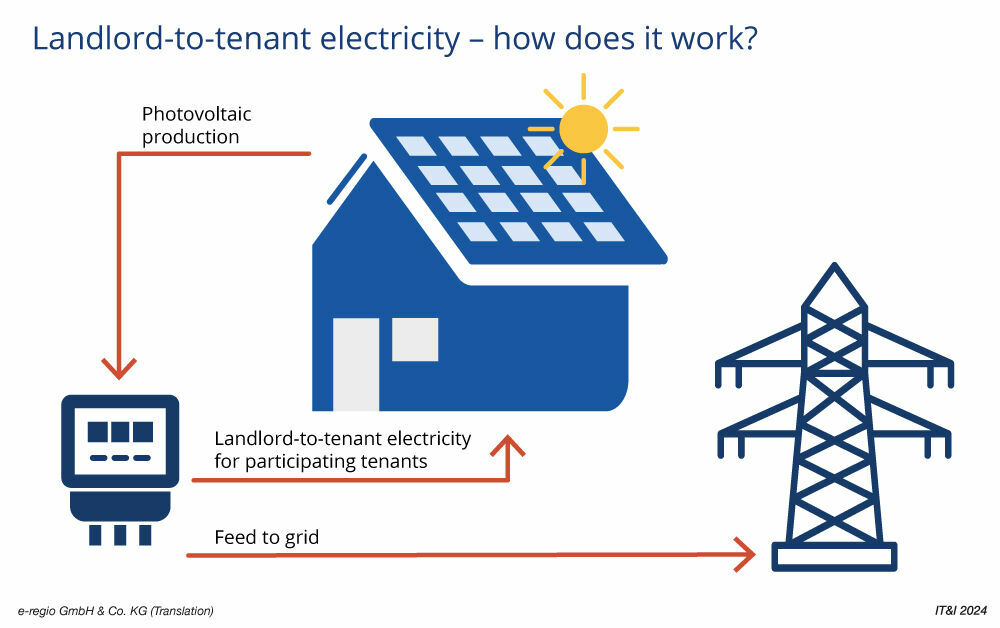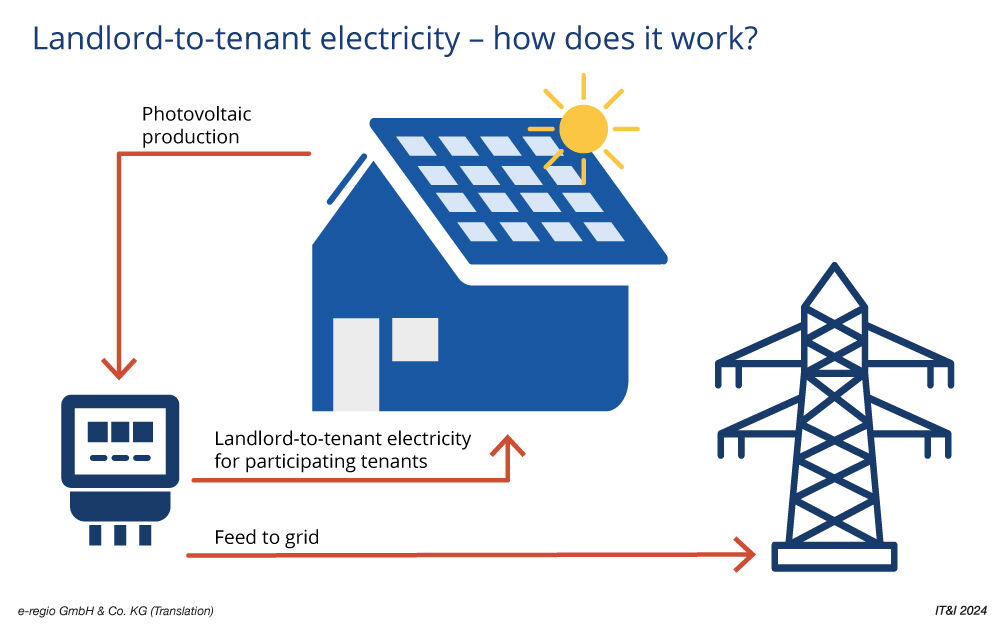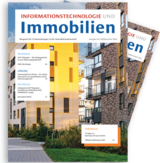Landlord-to-tenant electricity – a sustainable energy alternative

The model is fundamentally based on the principle of decentralised energy generation. This is often realised through photovoltaic systems on the roofs of apartment blocks, but also through combined heat and power plants (cogeneration units) and even small wind or bioenergy installations. The special feature of this model is that the electricity generated is supplied directly to the residents and users of the building, without having to go via the public electricity grid. Another key criterion of this model is the feeding of surplus electricity that is not consumed on site into the public grid. This is even remunerated, generating additional income and further increasing the efficiency of the energy supply.
Statutory funding and financial incentives
The adoption of the “Act on the Funding for Landlord-to-tenant Electricity Supply and the amendment of further provisions of the Renewable Energy Sources Act” in 2017 marked a turning point for the funding of landlord-to-tenant electricity projects in Germany. This law aims to remove barriers to the direct supply of electricity between producers and consumers in the same building and to create financial incentives for the installation of renewable energy sources. One key measure is the landlord-to-tenant electricity surcharge, which is granted in addition to the regular feed-in tariff and makes investments in corresponding systems more attractive. At the same time, the EEG levy was abolished on 1 January 2023, providing immediate relief for all landlord-to-tenant electricity suppliers.
However, the realisation of tenant electricity projects is quite challenging from a legal perspective. Especially if the EEG subsidy is to be obtained. Among other things, the following special features must be taken into account, which result from Section 42a EnWG, Sections 19 (1) no. 3, 21 (3), 23c EEG 2021:
- The electricity must come from solar installations with a maximum capacity of 100 kWp.
- It is not permitted to link the electricity supply contract with the rental contract.
- The electricity price may not exceed 90% of the basic supply tariff applicable in the respective grid.
- The maximum contract term is one year at the time of conclusion, after which tacit contract extensions are possible.
- The maximum cancellation period for the electricity supply contract may only be three months.
Many advantages for tenants and landlords
For tenants, landlord-to-tenant electricity projects not only offer the opportunity to benefit from lower electricity prices, as the service charges in particular are eliminated – they also allow them to make a direct contribution to environmental protection and the energy transition. By using locally generated, renewable electricity, tenants can significantly reduce their carbon footprint. The increased transparency about the origin and costs of electricity in turn raises tenants’ awareness of responsible energy consumption.
Landlords who invest in landlord-to-tenant electricity projects benefit from an upgrading of their properties and a positive public image. The installation of photovoltaic installations or other renewable energy sources can also increase the attractiveness of the residential or commercial space on offer for potential tenants and lead to a decisive competitive advantage. In addition, landlord-to-tenant electricity models open up new financial prospects through the direct marketing of the electricity generated to the tenants and the possibility of feeding surplus energy into the public grid and receiving remuneration for it.

Figure 1: Surplus electricity from landlord-to-tenant electricity production that is not consumed is fed into the public grid.
 Figure 1: Surplus electricity from landlord-to-tenant electricity production that is not consumed is fed into the public grid. |
Legal challenges and special features
Despite the obvious advantages, the implementation of landlord-to-tenant electricity projects naturally also entails extensive challenges. Creating the necessary energy installations requires specific expertise for their technical implementation and a high financial investment, which can be a hurdle for smaller landlords in particular. In addition, the regulatory environment for landlord-to-tenant electricity is complex and dynamic, which requires continuous monitoring and adaptation to new legal conditions. Ultimately, therefore, it is unlikely that owners will be able to successfully implement their plans without specialised legal assistance or the help of providers with relevant expertise.
Landlord-to-tenant electricity: the model of the future
Even though landlord-to-tenant electricity models have been practised for many years, their future in Germany is likely to be promising in view of the financial subsidies that have now been granted and the abolition of the EEG levy, especially against the backdrop of a growing awareness of sustainability and renewable energies.
In order to be able to exploit the full potential of landlord-to-tenant electricity, it is not only necessary to draw up the relevant contracts – as stipulated by law – but also to sensitise and, in particular, involve tenants. In return, landlord-to-tenant electricity projects offer the opportunity to actively shape the transition to a more sustainable and decentralised energy supply. They also represent an ecologically sensible alternative to conventional power supplies and can even help to reduce energy costs for consumers. Ultimately, landlord-to-tenant electricity projects are even able to make a significant contribution to achieving climate targets and lead to a more sustainable energy supply in the long term.
Author:

Stephan Wiedorfer-Rode
was born in 1967 in Munich. He studied law in Munich and, during his traineeship, worked in New York for six months for Germany’s largest record label. He has been a member of the bar since 1996 and founded his first law firm in 1999. He specialises in consulting in the field of computer and Internet law, including procedural enforcement of the relevant claims. His other areas of activity include trademark, copyright and competition law. Stephan Wiedorfer has been a certified specialist for industrial property rights since 4 February 2008. He is a member of the Deutsche Vereinigung für gewerblichen Rechtsschutz und Urheberrecht e. V. (GRUR; German Association for Industrial Property and Copyright), the Deutsche Gesellschaft für Recht und Informatik e. V. (DGRI; German Association for Law and Informatics)) and the Arbeitsgemeinschaft Informationstechnologie im Deutschen Anwaltverein (DAV-IT; Information Technology Working Group of the German Association of Lawyers).
Other articles by this author:
- Article "Compliance – what is actually still permitted today?"
- Article "Is the Internet of Things first and foremost an Internet of legal uncertainty?"
- Article "There was once a noticeboard... How to use social media channels in a legally compliant manner"
- Article "Digital butler or spyhole? What you need to consider when implementing a tenant app"
- Article "Contract design for software implementation – how significant are fairness and transparency?"
- Article "Everything is flowing smoothly – drafting contracts for agile projects"
- Article "WhatsApp in companies – how can it be used in a legally compliant way?"
- Article "What digital data rules are in place for asset and property management contracts?"
- Article "Smart, sure. But safe? Drones deployed for property management"
- Article "Are security vulnerabilities to hacker attacks a defect for which the software provider can be held liable?"
- Article "Gas prices are rising and the gas price cap is intended to remedy the situation."
- Article "Landlord-to-tenant electricity – a sustainable energy alternative"


